Triumph Spitfire Update!
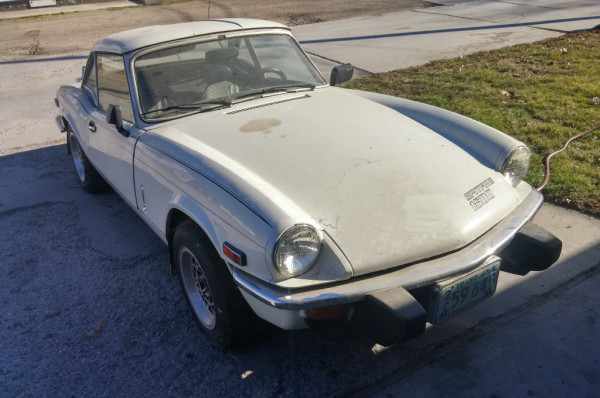
Well guys, I haven’t gotten around to doing an update on my 1978 Triumph Spitfire project and I realized it was time to give you guys some news. I bought this car a while back thinking it would be a fairly small project, but it has turned out to be a bit more work than originally expected. I quickly discovered that the motor was completely seized up. I was going to try to free it, but decided to just buy a running engine so I could get it back on the road and start enjoying the nice weather. So here is an update of what all has been done so far!
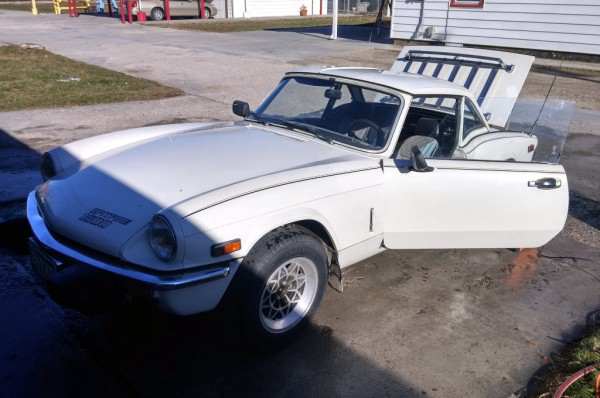
Through a wanted ad I was able to locate a used MG Midget engine, which is essentially the same motor, for just $500. It was still in the car and was running, so I was able to see it run and could perform a compression test. Everything looked good so we shook hands and the seller got to work pulling it out. It had what appeared to be a new carburetor on it, which happened to be leaking fuel badly, so rather than pay the seller extra I decided to let him keep the carburetor. I figured I had another complete engine with all the pieces I would need to make it run so I wouldn’t need it anyways. In hindsight I should have paid a little more, replaced the fuel bowl gasket, and left everything else alone. A few days later the engine was out and ready for me to pick it up, so I borrowed a truck and picked it up!
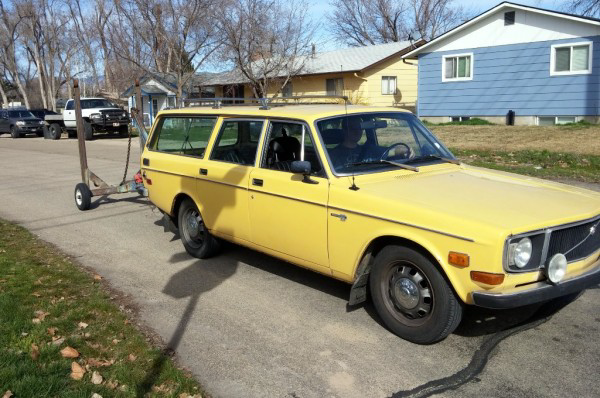
With the new engine home and more or less ready to go, I got to work pulling the old engine out of the Spitfire. Getting it out went as most tear downs do, smooth and quickly! I had ordered a new clutch and the gaskets that I knew needed replacing, so as soon as the old motor was out I would be ready to put the new one in. I still haven’t managed to get all of my tools and equipment moved over from Wyoming, so I had to rent an engine hoist to get the motor pulled out, but that only cost $20 a day. With the hoist ready to go, we pulled the old motor out in no time. (As you can see, the Volvo wagon made a good tow vehicle for the hoist!)
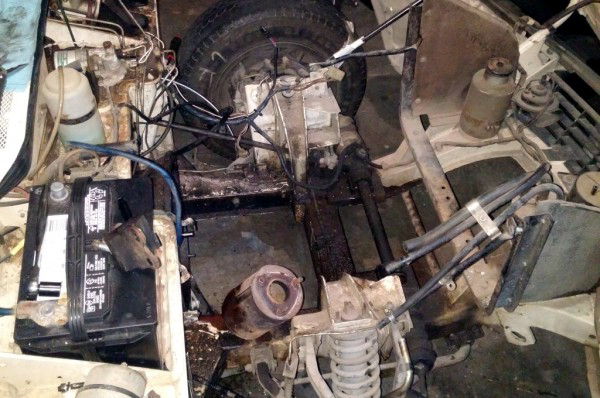
With both engines next to each other it was quite simple to move things around. We decided to leave the Midget exhaust and intake manifolds, as the Midget was an earlier car without all the emissions equipment. Since I didn’t pay for the extra carb, we moved the old one over to the new motor. With everything swapped over that looked like it needed to be changed we started the task of installing the motor. It was a bit tricky since we left the transmission in the car, but with some careful maneuvering and a few pizza breaks to ponder how to align it, we finally got everything lined up and back together. From here on out the job would be smooth sailing! Or at least that’s what I thought…

As soon as we had the engine in and everything hooked back up, I quickly discovered the exhaust manifold comes down at a different angle in a Midget, but switching manifolds isn’t that big of a problem. I did however discover the Spitfire’s manifold is cracked and by cracked I mean split in half, so a replacement still has to be found. I’ve started engines in the past without downpipes or mufflers, so I decided for a quick start up we could live without it. I hadn’t gotten around to cleaning the fuel tank, so we hooked up an external tank and prepared to attempt our first start. With the battery hooked up, the starter installed, all the wiring attached, and fuel ready to go, I put the key in the ignition and turned it over. The motor started spinning as it was suppose to, but nothing happened. I went into investigation mode! Engines only require a few basic things to run – air, fuel, and spark. My first place of investigation is almost always spark, as there are a lot of failure points in most ignition systems.
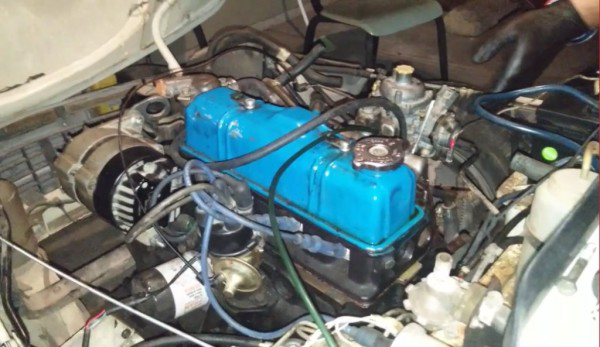
With one of the plugs out, I turned the motor over and discovered we weren’t getting a spark. That’s when it hit me, the Midget uses a 6 volt distributor and the Spitfire was setup to run 12 volts. I decided rather than switching over to 6 volts, I could just swap the distributors. Not wanting a big project I decided my best route was to switch just the top halves, with involves removing just one bolt. With the 12 volt unit mounted it was time for attempt #2. This time we got spark, but still no detonation. That left just one of two problems, either it wasn’t getting air or fuel. So off came the carb and once I had it torn down I discovered some problems.
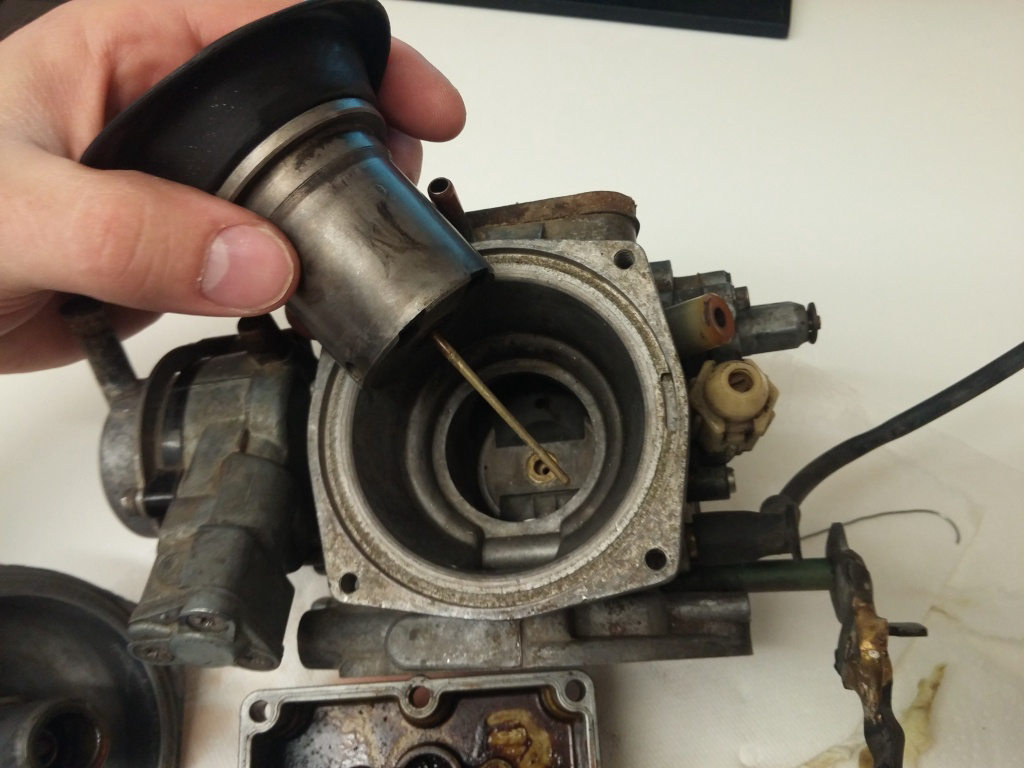
As you can see the fuel bowl was full of debris and the needle was sticking. Once I cleaned out all the gunk, everything seemed to be moving smoothly and as it should, so back on went the carb for attempt #3! With my heart pounding, I flipped the key over. The next thing I remember was a loud pop and the thought that I just destroyed the engine. Thankfully Jesse reminded me we don’t have the exhaust hooked up and he said to give it another try. The engine turned over easily, but still no luck starting it. Life, work, and school doesn’t leave me with a lot of spare time to fiddle with this car, but I don’t want to give up on it just yet, so I decided to turn to you guys for some help and advice.
Above is a quick video of the engine, so you can see and hear what it is doing. I’ve narrowed the issue down to just a few possibilities, either the distributor isn’t firing in the correct order or the carb isn’t giving it fuel. The question is, which one is it? I’m sure with our collective knowledge we can have this one figured out within just a few minutes, rather than tinkering with it on my own for days.
Auctions Ending Soon
 2002 Subaru Impreza WRXBid Now2 days$333
2002 Subaru Impreza WRXBid Now2 days$333
 1975 Chevrolet Corvette ConvertibleBid Now2 days$4,000
1975 Chevrolet Corvette ConvertibleBid Now2 days$4,000
 1964 Ford F-100 Camper CustomBid Now2 days$2,000
1964 Ford F-100 Camper CustomBid Now2 days$2,000
 2006 Jeep Wrangler SportBid Now4 days$11,000
2006 Jeep Wrangler SportBid Now4 days$11,000
 1974 Datsun 260ZBid Now6 days$750
1974 Datsun 260ZBid Now6 days$750

Comments
I would go two routes: 1) pour some gas down the carb and try turning it over (that way if you have some internal carb problems, the raw fuel might expose them, and 2) check your timing.
It sounds like your timing is off.
Perhaps 180°out?
Good luck.
Keep us posted.
sounds like distibutor out 180 degrees
Timing is 180 off, in my opinion
I agree it sounds like 180 Degrees out of time
The plugs fire 1-3-4-2 in counter clockwise order, if mrmory serves. If the
Midget was an older model it could have a positive ground, but I seriously doubt it had a 6 volt system. Sometimes, when changing ground polarity, there are little bits like coil connectors that need to be thought through, or even the insolated part that leads in to the distributor, or directly at the points. The SU carb is generally simpler and more reliable.
So we went and switched the spark plug wires around and it fired up! The timing was way off, so we adjusted it a bit and it fires right up without any issues!!
Ditch the Strom berg and get some su’s
Josh, look for an email later tonight with some thoughts…just getting back on the computer. Glad it’s running!
in the photo it looks like you are running the motor without coolant! the car should make a nice driver once you get it sorted. i see the 145 and what looks like an Audi in the photos but no mgb, other volvo or your 124. how are other project cars doing? do the houses in the background date from the mid 1950s?
Hi Jim,
I haven’t hooked up the cooling system yet, but I also haven’t run the engine for more than a couple rotations. We almost have it all hooked back up and should have it ready for a short drive around the block tomorrow. These are some of the last photos of the 145 before it went to its new owner. There is a bit of a gap between installing the motor and finally getting it running (I started a new section in calculus that has been taking up all my spare time). The car next to the Spitfire is my neighbors VW Passat, but it might as well be an Audi A4. The 122S is at Jesse’s house and my 124 is still in storage in Wyoming. As to the homes, I’m guessing most were built around the ’50s and ’60s, I know my apartment was built in the ’50s!
Was going to point out that it sounds like the distributor is out 180 degrees but it sounds like you got it. Neat little car.
So after looking through my photos of the car and the engine, I think I figured out what happened. It appears that the new motors distributor was out 180, but rather than pull it back out, they just reordered the spark plug wires. When I put the motor back together, I put the plugs on in the correct order, which was in this case the wrong order. With the cables reordered, it seems to fire up great! It probably isn’t the best solution, but if I don’t have to pull the distributor all the way out I’d rather not. We still have a lot of issues to deal with, but we are getting close!
I love those newer year spitfires with the hard tops! So nice looking! I am glad you got it running…. you’ll be cruising with the top down soon!
Glad it’s running but distributor is definitely out 180 degrees. Fix it properly if you can find the time. It is not that hard and it is the right thing to do and will save a lot of future confusion for you and others when timing the engine. Marking the distributor before removal would have prevented this confusion. Also, I am really disappointed that you didn’t at least try to free up the old engine as I described. It would have saved $500 and a whole lot of time, as well as kept the car a matching number original, and it will be much more difficult to free the engine out of the car because you lost the leverage of using the transmission to free it. Did you even try to free it up before removal?
Hi Chase,
I’m going to research the best way of pulling the distributor, so I don’t lose any parts down in the motor and spin it around 180. I want it done right, I just don’t have the time right now with finals coming up soon. Once summer starts I’ll get it straightened out properly!
I tried hard to get the original motor freed up, but after letting it sit with diesel for close to a month with no luck I decided to pull the oil pan. When I got it off I discovered a piece of the oil pump in the pan, plus part of a thrush washer. The guy I bought the new motor from actually knew this car back when it was first parked. He had looked at buying it then, but the motor was stuck back then, about 20 years ago and decided to pass as a result. With this info plus all the metal shavings in the pan I decided my best option was to replace the motor. I still have the original and once I have the car back on the road I’m going to pull the motor apart and see if it is salvageable. If it is I will have a shop bore it out, possibly resleeve it if necessary, and rebuild it to slightly better spec than original. I can then reinstall it and sell the new motor to someone else needing a motor for their Spitfire/Midget. I know it wasn’t the optimal situation, but I figured if the motor was seriously damaged it would have to come out anyway. Going this route, I have the motor out, can enjoy the car, and get my neighbor, roommate, and landlord off my back all at the same time!
Not sure if you have the Euro or US model but if it is the Euro that has two ports coming out of the exhaust manifold to the down pipe then I’ve got a new stainless exhaust system that will fit and can’t use it on my US model. I paid $400 – would let it go for the best offer that makes sense. I bought it from Rimmer and the cost to ship it back is about the same $400.
Rich…talk with Ted Schumacher at TS Imports if Josh doesn’t take you up; Ted sells a lot of Euro twin carb setups for 1500’s and some include the Euro exhaust manifold as well. Ted’s a great guy and might be able to put you in touch with folks he’s sold the setup to. As an alternative, if you purchase a header and install it, a good custom exhaust shop should be able to adapt the Rimmer system to a header (assuming it’s OK with the emissions police where you live). Good Luck!
Hi Rich, I’m definitely interested in the manifold. Could you email me a photo? You can just send it to [email protected].
Thanks!
Josh
Josh, I think he’s talking about an exhaust system, not a manifold…I made that mistake at first as well. Any US manifold only has one outlet…
a good source of info and cheap parts is the Spitfire Graveyard in Sheffield, England. My mate owns it and ships parts all over the world and knows these cars inside and out.
My personal favorite intake system for this motor is a single side draft weber, simple with no syncing and more options for jets etc. than you can count.